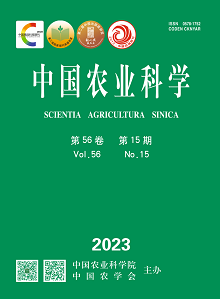【Objective】 Cucumber target leaf spot, caused by Corynespora cassiicola, has brought great economic losses to the cucumber industry. Sporulation and release of C. cassiicola spores play a significant role in the epidemiology of the disease. In this study, the regularity and the effect of humidity on sporulation and release of C. cassiicola, and the optimal application method and time for control of cucumber target leaf spot were evaluated.【Method】 The sporulation regularity of C. cassiicola was evaluated by quantifying the spore concentration on lesions of diseased cucumber leaves at 0: 00, 3: 00, 6: 00, 9: 00, 12: 00, 15: 00, 18: 00, and 21: 00, respectively. The release regularity of C. cassiicola was evaluated in different seasons of spring, summer, autumn and winter, air samples were collected from naturally infested cucumber greenhouse at 0: 00, 3: 00, 6: 00, 9: 00, 12: 00, 15: 00, 18: 00, and 21: 00, respectively, and the concentrations of C. cassiicola in the air were evaluated. The effect of relative humidity on sporulation and release of C. cassiicola was also assessed in artificial climate exposure chambers and plastic greenhouses at four different humidity conditions of continuous high humidity (RH>90%, 24 h), continuous low humidity (RH<60%, 24 h), high humidity for 12 h followed by low humidity for 12 h, and low humidity for 12 h followed by high humidity for 12 h. The control efficiency of 60% carbendazim·diethofencarb wettable powder (WP) and 500 million spores/g Pseudomonas fluorescens WP on cucumber target leaf spot disease was compared, by using powder spraying and water spraying at different application times in the field.【Result】 The study on the daily variation regularity of sporulation and release of C. cassiicola showed significant differences in the quantity of spores on diseased leaves and in the greenhouse air at different times of the day. There was a complementary relationship between the number of spores on diseased leaves and in the greenhouse air at the same time. After 18: 00, as the duration of high humidity (RH>90%) prolonged, the number of spores on diseased leaves increased, reaching a peak of 1 344 spores/cm2 at 6: 00 the next day. Then, the humidity decreased gradually to RH<60% after opening the air vent of the greenhouse, and spores were released into the greenhouse space. At 12: 00, the spore concentrations in the greenhouse air reached a peak of 12 445-110 697 spores/m3. In different seasons of spring, summer, autumn, and winter, the daily variation regularity of sporulation and release is consistent, showing that C. cassiicola produced a large amount of spores under high humidity (RH>90%) at night, and released to greenhouses under low humidity (RH<60%) during the day. In artificial climate exposure chambers and plastic greenhouses, the highest quantity of C. cassiicola spores was detected under alternating wet and dry conditions, which was significantly higher than that under continuous high humidity or continuous low humidity condition. By powder spraying at 19: 00, 60% carbendazim·diethofencarb WP and 500 million spores/g P. fluorescens WP gave the best control efficiency of 80.60% and 75.08%, respectively, and the spore inhibition efficiency was higher than 84%.【Conclusion】 Humidity is a key environmental factor affecting the spore reproduction and release of C. cassiicola. The alternating day-dry and night-wet environment in the greenhouse promotes the reproduction and diffusion of C. cassiicola, and accelerates the spread of cucumber target leaf spot. Powder spraying method is better than water spraying method for disease control, and the best application time is the evening before spore reproduction. The results of this study will contribute to the development of new strategies for the effective alleviation and control of cucumber target leaf spot.









